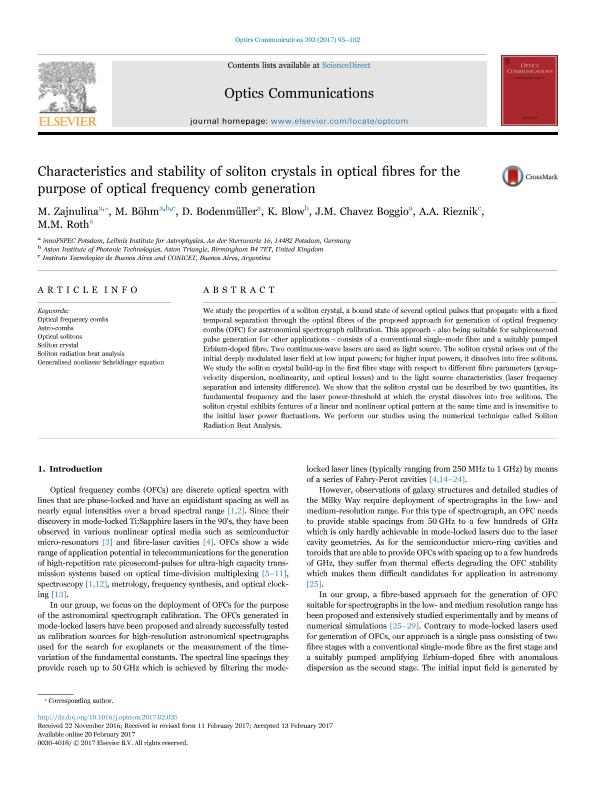Mostrar el registro sencillo del ítem
dc.contributor.author
Zajnulina, M.
dc.contributor.author
Bohm, M
dc.contributor.author
Bodenmüller, D.
dc.contributor.author
Blow, K.
dc.contributor.author
Chavez Boggio, J. M.
dc.contributor.author
Rieznik, Andrés Anibal

dc.contributor.author
Roth, M. M.
dc.date.available
2018-04-05T18:12:14Z
dc.date.issued
2017-06
dc.identifier.citation
Zajnulina, M.; Bohm, M; Bodenmüller, D.; Blow, K.; Chavez Boggio, J. M.; et al.; Characteristics and stability of soliton crystals in optical fibres for the purpose of optical frequency comb generation; Elsevier Science; Optics Communications; 393; 6-2017; 95-102
dc.identifier.issn
0030-4018
dc.identifier.uri
http://hdl.handle.net/11336/40940
dc.description.abstract
We study the properties of a soliton crystal, a bound state of several optical pulses that propagate with a fixed temporal separation through the optical fibres of the proposed approach for generation of optical frequency combs (OFC) for astronomical spectrograph calibration. This approach - also being suitable for subpicosecond pulse generation for other applications - consists of a conventional single-mode fibre and a suitably pumped Erbium-doped fibre. Two continuous-wave lasers are used as light source. The soliton crystal arises out of the initial deeply modulated laser field at low input powers; for higher input powers, it dissolves into free solitons. We study the soliton crystal build-up in the first fibre stage with respect to different fibre parameters (group-velocity dispersion, nonlinearity, and optical losses) and to the light source characteristics (laser frequency separation and intensity difference). We show that the soliton crystal can be described by two quantities, its fundamental frequency and the laser power-threshold at which the crystal dissolves into free solitons. The soliton crystal exhibits features of a linear and nonlinear optical pattern at the same time and is insensitive to the initial laser power fluctuations. We perform our studies using the numerical technique called Soliton Radiation Beat Analysis.
dc.format
application/pdf
dc.language.iso
eng
dc.publisher
Elsevier Science

dc.rights
info:eu-repo/semantics/openAccess
dc.rights.uri
https://creativecommons.org/licenses/by-nc-nd/2.5/ar/
dc.subject
Astro-Combs
dc.subject
Generalised Nonlinear Schr&Amp;Ouml;Dinger Equation
dc.subject
Optical Frequency Combs
dc.subject
Optical Solitons
dc.subject
Soliton Crystal
dc.subject
Soliton Radiation Beat Analysis
dc.subject.classification
Astronomía

dc.subject.classification
Ciencias Físicas

dc.subject.classification
CIENCIAS NATURALES Y EXACTAS

dc.title
Characteristics and stability of soliton crystals in optical fibres for the purpose of optical frequency comb generation
dc.type
info:eu-repo/semantics/article
dc.type
info:ar-repo/semantics/artículo
dc.type
info:eu-repo/semantics/publishedVersion
dc.date.updated
2018-04-05T13:45:23Z
dc.journal.volume
393
dc.journal.pagination
95-102
dc.journal.pais
Países Bajos

dc.journal.ciudad
Amsterdam
dc.description.fil
Fil: Zajnulina, M.. Leibniz Institute for Astrophysics; Alemania
dc.description.fil
Fil: Bohm, M. Leibniz Institute for Astrophysics; Alemania. Aston Institute of Photonic Technologies; Reino Unido
dc.description.fil
Fil: Bodenmüller, D.. Leibniz Institute for Astrophysics; Alemania
dc.description.fil
Fil: Blow, K.. Aston Institute of Photonic Technologies; Reino Unido
dc.description.fil
Fil: Chavez Boggio, J. M.. Leibniz Institute for Astrophysics; Alemania
dc.description.fil
Fil: Rieznik, Andrés Anibal. Instituto Tecnológico de Buenos Aires; Argentina. Consejo Nacional de Investigaciones Científicas y Técnicas; Argentina
dc.description.fil
Fil: Roth, M. M.. Leibniz Institute for Astrophysics; Alemania
dc.journal.title
Optics Communications

dc.relation.alternativeid
info:eu-repo/semantics/altIdentifier/doi/http://dx.doi.org/10.1016/j.optcom.2017.02.035
dc.relation.alternativeid
info:eu-repo/semantics/altIdentifier/url/https://www.sciencedirect.com/science/article/pii/S0030401817301232
Archivos asociados
